What Is Regulated Medical Waste (RMW)?
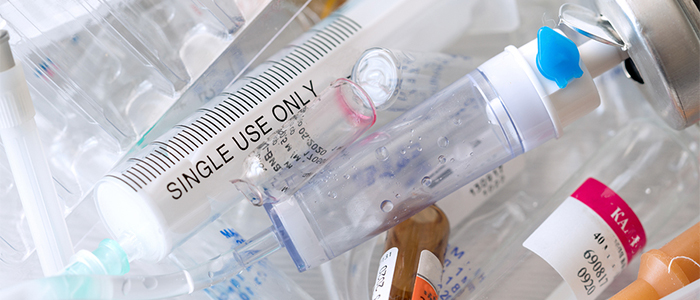
Regulated medical waste (RMW)—also known as “biohazardous” or “infectious medical” waste—refers to wastes that contain blood, body fluids, or other potentially infectious materials like sharps, as a result posing a risk of transmitting infection.
There are several main categories of RMWs, including:
- Pathological and anatomical wastes
- Blood, body fluids, and OPIMs
- Microbiological waste
- Sharps
- Isolation wastes
- Animal waste
To learn more about each category of regulated medical waste and how to dispose of it, watch the video or read the transcript below.
Video Transcript
How OSHA Defines RMW
The Occupational Safety and Health Administration (OSHA) formally defines regulated medical waste as any waste that meets any 1 of the 5 conditions below:
- Liquid/semi-liquid blood or other potentially infectious materials
- Items that would release blood or other potentially infectious materials in a liquid or semi-liquid state if compressed
- Items with dried blood or other potentially infectious materials and are capable of releasing these materials during handling
- Microbiological wastes containing blood or other potentially infectious materials
- Contaminated sharps
Pathological & Anatomical Waste
Generally speaking, pathological and anatomical waste is considered to be waste that comes from human body parts, tissues, and organs. It’s important to note that standards can differ from state to state. Some states don’t consider hair, teeth, and nails as pathological waste.
The Difference Between Pathological & Anatomical Waste
Although both waste types come from the human body, there are differences between the two.
Pathological Waste
Typically, pathological waste is smaller, referring to the very small tissue sections and body materials coming from surgical procedures and biopsies that get examined in laboratories.
Anatomical Waste
Anatomical waste is typically the larger type of human waste. Common examples include organs, tissue, and body parts, which can require special handling compared to other pathological wastes.
Blood, Body Fluids, & Other Potentially Infectious Materials (OPIM)
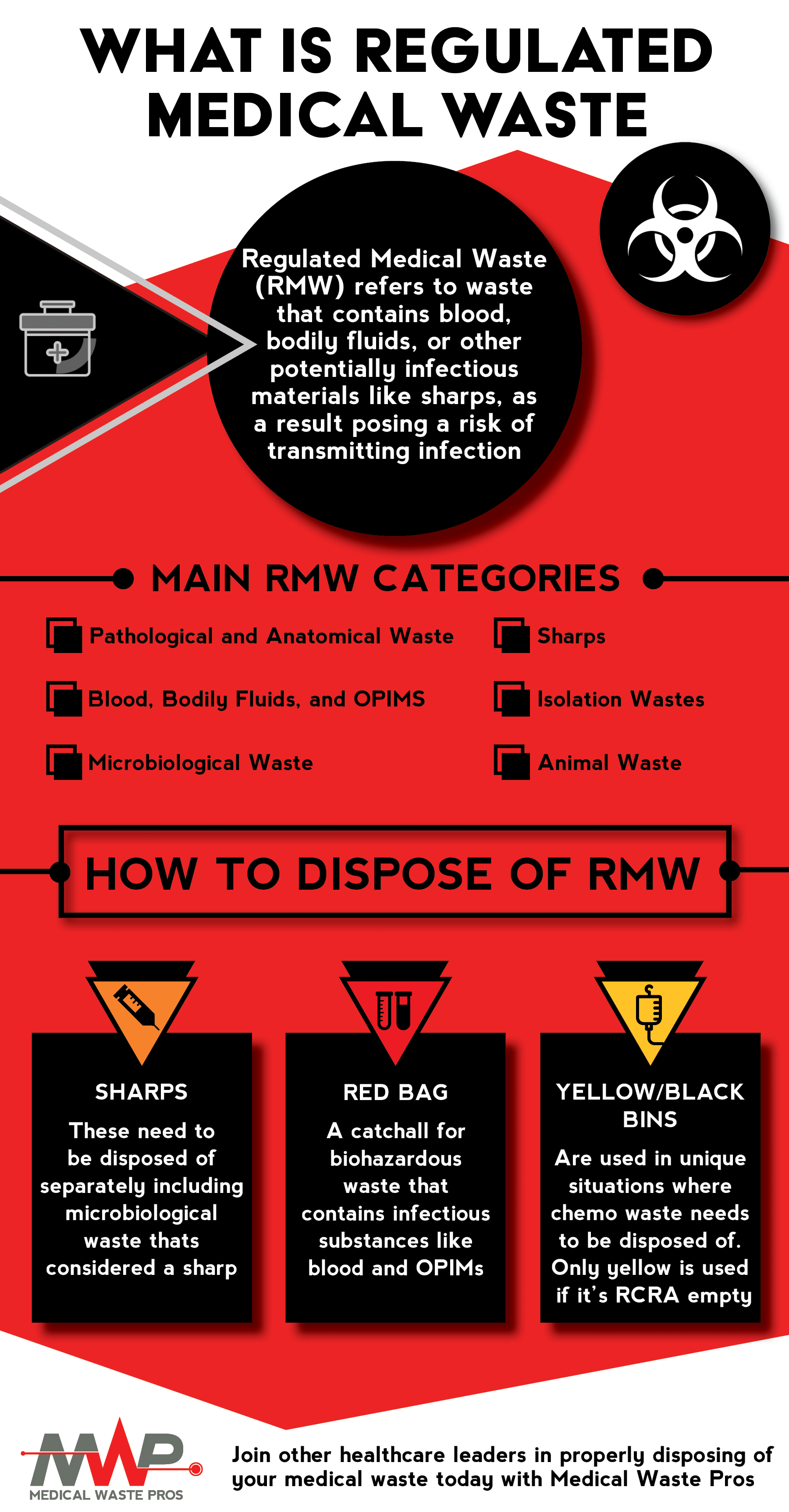 OPIMs are primarily thought of as blood or various blood products. However, they can include lab samples of fluids, drainage from surgeries, and urine or feces contaminated by blood as well.
OPIMs are primarily thought of as blood or various blood products. However, they can include lab samples of fluids, drainage from surgeries, and urine or feces contaminated by blood as well.
Besides blood and blood components or products, such as serum and plasma, OSHA defines a range of different wastes as another potentially infectious material:
- Cerebrospinal fluid
- Synovial fluid
- Pleural fluid
- Pericardial fluid
- Peritoneal fluid
- Amniotic fluid
- Semen
- Vaginal secretions
- Saliva in dental procedures
- Body fluids containing blood
Microbiological Waste
Microbiological waste is most common in laboratories where waste originates from clinical or research procedures involving communicable infectious agents. This category includes waste types ranging from infectious agents to biologicals and microorganisms.
Types of Microbiological Waste
There’s a wide range of infectious agents, biologicals, and microorganisms that classify as microbiological waste:
- Culture dishes and transfer devices
- Inoculate and mixed cultures
- Discarded cultures
- Specimens
- Stocks
- Sharps
Other microbiological wastes include live and attenuated vaccines containing organisms that are likely pathogenic to healthy people and similarly discarded etiological agents and wastes from producing biologicals and antibiotics that have been contaminated by potentially pathogenic organisms.
Sharps Waste
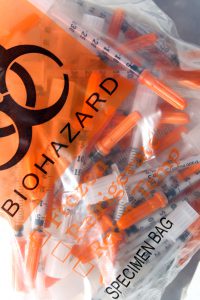 Sharps is a blanket term for all types of waste that can puncture or lacerate the skin, such as a hypodermic needle or syringe. The medical industry uses them in a variety of places and for a variety of reasons, making them one of the most common types of medical waste.
Sharps is a blanket term for all types of waste that can puncture or lacerate the skin, such as a hypodermic needle or syringe. The medical industry uses them in a variety of places and for a variety of reasons, making them one of the most common types of medical waste.
Specific Sharps Waste Types
An item is considered a sharp if it either can induce subdermal inoculation of infectious agents or can penetrate the skin and puncture waste bags or cardboard boxes. Sharps types include:
- Hypodermic needles
- Syringes
- Capillary tubes
- Pasteur pipettes
- Razor & scalpel blades
- Retractable needles
- Heel lancers
- Needleless injection devices
Isolation Wastes from Highly-Communicable Diseases
Isolation wastes are generally defined as biological waste and any other materials contaminated with blood, excretion, or secretion from animals and humans who’ve been isolated to protect others from highly communicable diseases.
Common types of highly-communicable diseases include:
- Ebola virus
- Tuberculosis
- Hepatitis A/B
- West Nile Virus
- STDs
- Rabies
Animal Wastes
Besides all other RMW types, animal waste is a different category. Animal waste types include:
- Carcasses
- Body parts
- Bedding
- Production of biologicals
- Testing of pharmaceuticals
- Any other wastes exposed to an infectious agent
How to Dispose RMW
Although these types of medical waste are considered RMW, when it comes to medical waste disposal some RMW types need to be separated first.
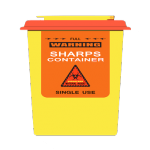 Sharps Container Sharps Container |
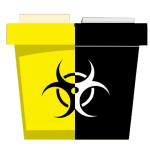 Yellow/Black Container Yellow/Black Container |
|
| Used sharps must be disposed of in separate containers from other types of waste and require special handling under OSHA & DOT. It’s important to note microbiological waste that’s considered sharp should also be disposed of in these containers. | Red bags are used as a catchall for disposing of biohazardous waste that contains potentially infectious substances like blood. Among the various RMW types, this includes OPIMs, pathological waste, and microbiological waste. | Yellow and black bins are used in more unique situations where chemotherapy waste needs to be disposed of separately from other medical waste. Yellow is only for “RCRA empty”, while black is for bulk. Wastes can include pathological waste, IV bags, and vials. |
Have Regulated Medical Waste to Dispose?
Medical Waste Pros partners with reliable and compliant RMW disposal providers for the healthcare industry. Let us help you take care of your regulated medical waste by calling (888) 755-6370 or filling out our form for a free, no-obligation quote from a provider in your area.










